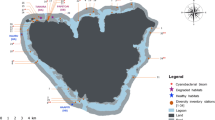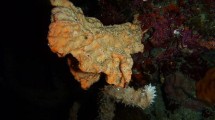Abstract
Okinawa is the southwesternmost part of Japan and represents the northern limit of coral reefs that are influenced by the Kuroshio warm current. We have been studying two coral reefs off Sesoko Island, in northern Okinawa, to evaluate coral reef environments since 2014. In this study, we applied a metagenomic approach to analyze the seasonal composition of picophytoplankton at these two reef sites (Sesoko Minami and Ishikawabaru). The two sites were selected for their differences: Sesoko Minami faces the open ocean and experiences relatively small land effects, while Ishikawabaru experiences relatively high land effects and is surrounded by barrier reefs. Seawater samples were collected from these two sites and filtered through a 1.6 μm pore filter followed by a 0.2 μm membrane filter. DNA was extracted from the 0.2 μm filters, and the V1-V2 region of the 16S rRNA gene (260 bp) was amplified before sequencing using next-generation sequencing techniques. Cyanobacteria or chloroplast sequences were selected for further metabarcording analyses. Interestingly, almost no differences were indicated between the two sites and more than 95% of the picophytoplankton at both sampling sites was composed of only 5 to 7 OTUs. The seasonal composition of picophytoplankton clearly changed; in summer (Jul 2014, May to Jul 2015, and May to Aug 2016) OTU 1 (Synechococcus sp. NC007513) was most abundant. OTU 4 (Prochlorococcus marinus NC009091) also reached its maximum abundance in summer (May to Aug 2016), while OTU 6 (Bathycoccous prasinos FN563099) increased in winter. OTU 8 (Micromonas commoda RCC299 FJ858267) was present at every sampling period and accounted for 5–20% of the total picophytoplankton contig numbers. Our results indicate that seasonal changes clearly influence fluctuations in picophytoplankton community compositions.



Similar content being viewed by others
References
Agawin NSR, Duarte CM, Agusti S (2000) Nutrient and temperature control of the contribution of picoplankton to phytoplankton biomass and production. Limnol Oceanogr 45:591–600
Bec B, Husseini-Ratrema J, Collos Y, Souchu P, Vaquer A (2005) Phytoplanton seasonal dynamics in a Meditteranean coastal lagoon: emphasis on picoeukaryot community. Plankton Res 27:881–894
Bosak S, Silovic T, Ljubesic Z, Kuspilic G, Pestoric B, Krivokapic S, Vilicic D (2012) Phytoplankton size structure and species composition as an indicator of trophic status in transitional ecosystems: the case study of a Mediterranean fjord-like karstic bay. Oceanologia 54:255–286
Buitenhuis ET, Vogt M, Moriarty R, Bednaršek N, Doney SC, Leblanc K, LeQuéré C, Luo YW, O’Brien C, O’Brien T, Peloquin J, Schiebel R, Swan C (2013) MAREDAT: towards a world atlas of MARine ecosystem DATa. Earth Syst Sci Data 5:227–239
Campbell L, Nolla HA, Vaulot D (1994) The importance of Prochlorococcus to community structure in the central north pacific-ocean. Limnol Oceanogr 39:954–961
Campbell L, Liu HB, Nolla HA, Vaulot D (1997) Annual variability of phytoplankton and bacteria in the subtropical North Pacific Ocean at station ALOHA during the 1991–1994 ENSO event. Deep Sea Res I 44:167–192
Chen B, Liu H, Huang B, Wang J (2014) Temperature effects on the growth rate of marine picoplankton. Mar Ecol Prog Ser 505:37–47
Chung CC, Chang J, Gong GC, Hsu SC, Chiang KP, Liao CW (2011) Effects of Asian dust storms on Synechococcus populations in the subtropical Kuroshio Current. Mar Biotechnol 13:751–763
Cai YM, Ning XR, Liu CG, Hao Q (2007) Distribution pattern of photosynthetic picoplankton and heterotrophic bacteria in the northern South China Sea. J Integr Plant Biol 49:282–298
Cuvelier ML, Allen AE, Monier A, McCrow JP, Messié M, Tringe SG, Woyke T, Welsh RM, Ishoey T, Lee JH, Binder BJ, DuPont CL, Latasa M, Guigand C, Buck KR, Hilton J, Thiagarajan M, Caler E, Read B, Lasken RS, Chavez FP, Worden AZ (2010) Targeted metagenomics and ecology of globally important uncultured eukaryotic phytoplankton. Proc Nat Acad Sci 107:14679–14684
Diez B, Nylander JAA, Ininbergs DCL, Allen AE, Yooseph S, Rusch DB, Bergman B (2016) Metagenomic analysis of the Indian ocean picocyanobacterial community: structure, potential function and evolution. PLoS One 11:e0155757
Donia MS, Fricke WF, Partensky F, Cox J, Elshahawi SI, White JR, Phillippy AM, Schat MC, Piel J, Haygood MG, Ravel J, Schmidt WE (2011) Complex microbiome underlying secondary and primary metabolism in the tunicate-Prochloron symbiosis. Proc Nat Acad Sci USA 108:1423–1432
Dubelaar GBJ, Casotti R, Tarran GA, Biegala IC (2007) Phytoplankton and their analysis by flow cytometry. In: Doležel J, Greilhuber J, Suda J (eds) Flow cytometry with plant cells: analysis of genes, chromosomes and genomes. Wiley-VCH Verlag, Weinheim, pp 287–322
DuRand MD, Olson RJ, Chisholm SW (2001) Phytoplankton population dynamics at the Bermuda Atlantic Time-series station in the Sargasso Sea. Deep-Sea Res II 48:1983–2003
Flombaum P, Gallegos JL, Gordillo RA, Rincón J, Zabala LL, Jiao N, Karl DM, Li WKW, Lomas MW, Veneziano D, Vera CS, Vrugt JA, Martiny AC (2013) Present and future global distributions of the marine cyanobacteria Prochlorococcus and Synechococcus. Proc Nat Acad Sci 110:9824–9829
Flores R, Shi J, Gail MH, Gajer P, Ravel J, Goedert JJ (2012) Assessment of human fecal microbiota: II. Reproducibility and associations of 16S rRNA pyrosequences. Eur J Clin Investig 42(8):855–843
Fouhy F, Clooney AG, Stanton C, Claesson MJ, Cotter PD (2016) 16S rRNA gene sequencing of mock microbial populations—impact of DNA extraction method, primer choice and sequencing platform. BMC Microbiol 16(123):1–13
Ganesh S, Parris DJ, DeLong EF, Stewart FJ (2014) Metagenomic analysis of size-fractionated picoplankton in marine oxygen minimum zone. ISME J 8:187–211
Gong GC, Shiah FK, Liu KK, Chuang WS, Chang J (1997) Effect of the Kuroshio intrusion on the chlorophyll distribution in the southern East China Sea during spring 1993. Cont Shelf Res 17:79–94
Gong GC, Chang J, Wen YH (1999) Estimation of annual primary production in the Kuroshio waters northeast of Taiwan using a photosynthesis-irradiance model. Deep Sea Res I 46:93–108
Grossman AR, Mackey KRM, Bailey S (2010) A perspective on photosynthesis in the oligotrophic oceans: hypotheses concerning alternate routes of electron flow. J Phycol 46:629–634
Grzymski JJ, Riesenfeld CS, Williams TJ, Dussaq AM, Ducklow H, Erickson M, Cavicchioli R, Murray AE (2012) A metagenomic assessment of winter and summer bacterioplankton from Antartica Peninsula coastal surface waters. ISME J 6:1901–1915
Guo C, Liu H, Zheng L, Song S, Chen B, Huang B (2014) Seasonal and spatial patterns of picophytoplankton growth, grazing and distribution in the East China Sea. Biogeosciences 11:1847–1862
Hartmann M, Zubkov MV, Scanlan DJ, Lepere C (2013) In situ interactions between photosynthetic picoeukaryotes and bacterioplankton in the Atlantic Ocean: evidence for mixotrophy. Environ Microbiol Rep 5:835–840
Jiang X, Li J, Ke Z, Xiang C, Tan Y, Huang L (2017) Characteristics of picoplankton abundances during a Thalassiosira diporocyclus bloom in the Taiwan Band in late winter. Mar Pollut Bull 117:66–74
Jiao N, Yang Y, Hong N, Ma Y, Harada S, Koshikawa H, Watanabe M (2005) Dynamics of autotrophic picoplankton and heterotrophic bacteria in the East China Sea. Cont Shelf Res 25:1265–1279
Katano T, Kaneda A, Kanzaki N, Obayashi Y, Morimoto A, Onitsuka G, Yasuda H, Mizutani S, Kon Y, Hata K, Takeoka H, Nakano S (2007) Distribution of prokaryotic picophytoplankton from Seto Inland Sea to the Kuroshio region, with special reference to ‘Kyucho’ events. Aquat Microb Ecol 46:191–201
Lee Y, Choi JK, Youn S, Roh S (2014) Influence of the physical forcing of different water masses on the spatial and temporal distributions of picophytoplankton in the northern East China Sea. Cont Shelf Res 88:216–227
Li J, Jiang X, Li G, Jing Z, Zhou L, Ke Z, Tan Y (2017) Distribution of picophytoplankton in the northeastern South China Sea with special reference to the effects of the Kuroshio intrusion and associated mesoscale eddies. Sci Total Environ 598:1–10
Liu H, Nolla HA, Campbell L (1997) Procolorococcus growth rate and contribution to primary production in the equatorial and subtropical North Pacific Ocean. Aquat Microb Ecol 12:37–47
Loya Y, Sakai K, Yamamoto K, Nakano Y, Sabali H, Van Woesik R (2001) Coral bleaching: the winners and the losers. Ecol Lett 4:122–131
Malmstrom RR, Coe A, Kettler GC, Martiny AC, Frias-Lopez J, Zinser ER, Chisholm SW (2010) Temporal dynamic of Prochorococcus ecotypes in the Atlantic and Pacific Oceans. ISME J 4, 1252–1264
Massana R (2011) Eukaryotic picoplankton in surface oceans. Annu Rev Microbiol 65:91–110
Moreira D, Rodríguez-Valera F, López-García P (2006) Metagenomic analysis of mesopelagic Antarctic plankton reveals a novel deltaproteobacterial group. Microbiology 152:505–517
Moore LR, Rocap G, Chisholm SW (1998) Physiology and molecular phylogeny of coexisting Prochlorococcus ecotypes. Nature 393:464–467
Moore LR, Chisholm SW (1999) Photophysiology of the marine cyanobacterium Prochlorococcus: ecotypic differences among cultured isolates. Limnol Oceanogr 44:628–638
Moore LR, Post AF, Rocap G, Chisholm SW (2002) Utilization of different nitrogen sources by the marine cyanobacteria Prochlorococcus and Synechococcus. Limnol Oceanogr 47:989–996
Moore LR, Ostrowski M, Scanlan DJ, Feren K, Sweetsir T (2005) Ecotypic variation in phosphorus acquisition mechanisms within marine picocyanobacteria. Aquat Microb Ecol 39:257–269
Nurdiani D, Ito M, Maruyama T, Terahara T, Mori T, Ugawa S, Takeyama H (2015) Analysis of bacterial xylose isomerase gene diversity using gene-targeted metagenomics. Biosci Bioeng 120:174–180
Not F, Latasa M, Marie D, Cariou T, Vaulot D, Simon N (2004) A single species, Micromonas pusilla (Prasinophyceae), dominates the eukaryotic picoplankton in the western English Channel. Appl Environ Microbiol 70:4064–4072
Palenik B, Ren Q, Tai V, Paulsen IT (2009) Coastal Synechococcus metagenome reveals major roles for horizontal gene transfer and plasmids in population diversity. Environ Microbiol 11:349–359
Partensky F, Hess WR, Vaulot D (1999) Prochlorococcus: a marine photosynthetic prokaryote of global significance. Microbiol Mol Biol Rev 63:106
Robertson V, Haltli B, McCauley E P, Overy D P, Kerr R G (2016) Highly variable bacterial communities associated with the octacoral Antillogorgia elisabethae. Miroorgan 4:23. https://doi.org/10.3390/microorganisms4030023
Rognes T, Flouri T, Nichols B, Quince C, Mahé F (2016) VSEARCH: a versatile open source tool for metagenomics. PeerJ 4:e2584. https://doi.org/10.7717/peerj.2584
Salipante S J, Kawashima T, Rosenthal C, Hoogestraat D R, Cummings L A, Sengupta D J, Harkins T T, Cookson B T, Hoffman N G (2014) Performance comparison of Illumina and Ion Torrent next-generation sequencing plattoforms for 16S rRNA-based bacterial community profiling. Appl Envion Microbiol 24:7583–7591
Shi Y, Tyson GW, Eppley JM, DeLong EF (2011) Integrated metatranscriptomic and metagenomic analyses of stratified microbial assemblages in the open ocean. IMSE J 5:999–1013
Tada K, Sakai K, Nakano Y, Takemura A, Montani S (2003) Size-fractionated phytoplankton biomass in coral reef waters off Sesoko Island, Okinawa, Japan. J Plankton Res 25:991–997
Thomsen HA, Buck KR (1998) Nanoflagellates of the central California waters: taxonomy, biogeography and abundance of primitive, green flagellates (Pedinophyceae, Prasinophyceae). Deep Sea Res II 45:1687–1707
Throndsen J (1969) Flagellates of Norwegian coastal waters. Nytt Mag Bot 16:161–214
Throndsen J, Zingone A (1994) Micromonads of the Mediterranean sea. Gior Bot Ital 128:1031–1044
Worden AZ (2006) Picoeukaryote diversity in coastal waters of the Pacific Ocean. Aquat Microb Ecol 43:165–175
Yu Z, Morrison M (2004) Improved extraction of PCR-quality community DNA from digesta and fecal samples. Biotechniques 36:808–812
Yoon TH, Kang HE, Kang CK, Lee SH, Ahn DH, Park H, Kim HW (2016) Development of a cost-effective metabarcoding strategy for analysis of the marine phytoplankton community. PeerJ 4:e2115. https://doi.org/10.7717/peerj.2115
Zingone A, Harrison PJ, Kraberg A, Lehtinen S, Gallop AM, O’Brein T, Sun J, Jakobsen HE (2015) Increasing the quality, comparability and accessibility of phytoplankton species composition time-series data. Estuar Coast Shelf Sci 162:151–160
Zinser ER, Johnson ZI, Coe A, Karaca E, Veneziano D, Chisholm SW (2007) Influence of light and temperature on Prochlorococcus ecotype distributions in the Atlantic Ocean. Limnol Oceanogr 52:2205–2220
Funding
This study was supported by the grant from JST-CREST, “Construction of the environmental risk mathematical model by the meta-omits analyses of marine uncultivable microbes based on single cell genome information.
Author information
Authors and Affiliations
Corresponding author
Rights and permissions
About this article
Cite this article
Nuryadi, H., Nguyen, T.T.M., Ito, M. et al. A metabarcoding survey for seasonal picophytoplankton composition in two coral reefs around Sesoko Island, Okinawa, Japan. J Appl Phycol 30, 3179–3186 (2018). https://doi.org/10.1007/s10811-018-1544-9
Received:
Revised:
Accepted:
Published:
Issue Date:
DOI: https://doi.org/10.1007/s10811-018-1544-9




